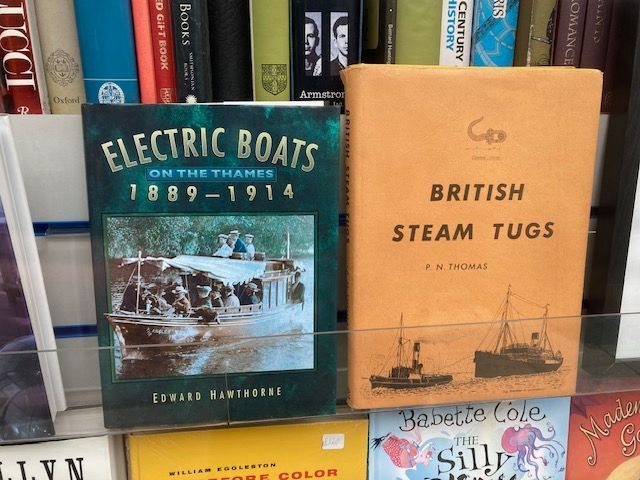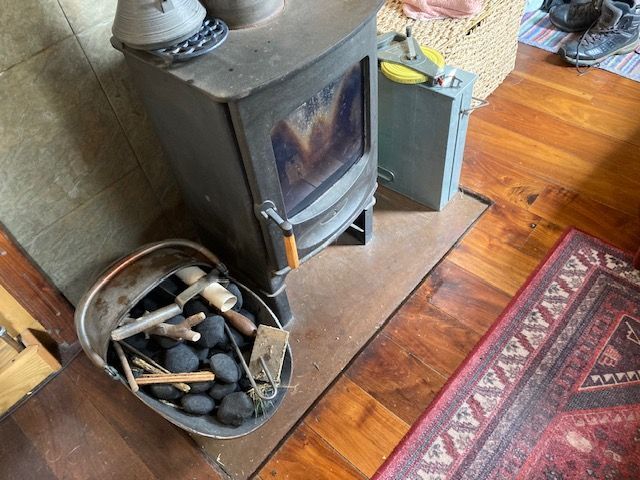-
Posts
11,512 -
Joined
-
Last visited
-
Days Won
4
Content Type
Profiles
Forums
Events
Gallery
Blogs
Store
Everything posted by dmr
-
It was a while ago I did mine, but pretty sure there is a lip sticking up that goes inside the smoke box, so the smoke box will have to lift up maybe 10 or 15mm, so the flue has to come off. Also the flue might be well stuck into the old smoke box. Ideally the flue should not touch the collar, there should be a gap filled with rope and sealant or fire cement. Have a look and see if you can poke it out. When you redo it use rope and high temp silicone, and very high temp silicone at the stove end. Fire cement is pretty much rubbish on boats. If you are really keen this could be a good time to take the chimney collar off, check for rust under it, and put it back on with suitably greased bolts.
-
The Fogstar does ignore low currents, and sometimes appears to diverge significantly from the BMV at higher currents, especially on charging. However despite this, and surprisingly, the Fogstar state of charge agrees surprisingly well with the BMV. I've not been up to 100% for a couple of months now (so no resynching). Fogstar says 88%, BMV says 80%, though I suspect these are both over estimates. and while on the subject of real world observation on a real battery 😀, The Fogstar Pro has an external balancer but also a moderately pathetic built in passive balancer. The battery has been in use since February and all cells are still within 10mV so I suspect I might never need to use the external active balancer.
-
The Victron Orion does sense engine running, I think it uses an internal accelerometer, Victron are proud of this, but just sensing input voltage is more reliable. I think Victron must be trying to cope with some really obscure edge case. I've set my Orion to a slightly low voltage (I think 14.1 or maybe 14.15) and a very short absirption time, so it helps with the Lithium bulk charge then dips out as soon as the batteries get close to absorption. The main alternator and Zeus then handle the final bit of the charge cycle. I reckon its best to have only one charging source doing the last bit of the charge. We are still static due to canal failures so I just run the engine once every few days to put a bit of charge into the batteries though I really should do a 100% charge before long just to resynch everything. I suspect the Victron BMV is actually doing a bit better than the Fogstar BMS at tracking SoC. Its true what Nick and others say, you really can get very relaxed about battery charging with lithiums....put a bit in, take a bit out as the fancy takes.
-
I spoke to ABNB a while ago about this, and they thought they could do it all with photos (and I assume a small fee) but life got busy and so I did not persue this.
-
I believe insurance companies use them to deduce premiums, and often do (or have) only used the first bit of the postcode. This would mean that somebody who keeps a car on the genteel Isle of Wight pays a premium as if they lived in urban Portsmouth 😀
-
As Gumpy has said, the postcodes don't even get the county correct. Our winter mooring is in West Yorkshire but our postcode is Oldham which is Greater Manchester, or previously Lancashire. I note that many of the internet shopping "find my address from Postcode" options give us a Lancashire address.
-
Its the wind at Hawksbury that makes it difficult, we have really messed it up once, though that was a while ago. The Macc is difficult, especially now there is a boat moored almost opposite, but at the Macc you go in knowning its going to be a slow figit with a fair bit of reversing/turning on the spot needed. At Hawksbury you always think you just might get round in one so maybe go in a little too fast then get all upset when you have to do a reverse that you had not 100% prepared for?
-
But there is one lock half way down where it all goes horribly wrong when you do that. 😀
-
I assume the Stratford Avon? There are a couple of locks that are really difficult for full length boats, especially Evesham? so faffing about and micro positioning (and other preparations) are to be expected. What irritates me is when we share with a single hander and they rigidly stick to their slow single handing method when it could all be so much quicker if they worked as a team. There really is no need to rope up, or go up and down the ladder, when sharing a lock (with a few exceptions).
-
Running on HVO these days, the exhaust smells crap. You have mentioned the poor exhaust smell a few times over the years. I wonder if you got your BD3 just as the sulphur was taken out of diesel? or do your real vintage engines really produce a better exhaust smell? I wonder if NOx is somehow a factor and how much NOx do your old engines produce? NOx is down to the peak temperature during combustion and I suspect the old engines might be quite good as they do not work so hard........out of my depth here though.
-
The only real unknown here is who is the manufacter whos manual you should read? Is it the company who made the engine? or the (often much smaller) mariniser who likely does not have full trchnical knowlendge of the engine. My case is a bit of an extreme one as we have the Beta JD3/John Deere 3029, and this spends most of its life at a speed below its designed tickover speed. I am relieved that my running in method gets your approval 😀
-
- 1 reply
-
- 1
-

-
Its the same as the shiney boat problem, a pristine sheet of copper with a single scratch looks naff, an old bit of copper with 1000 scratches and a few little dents looks good. I've just been doing some brass door panel bottoms (like 5 mins ago 😀), let them tarnish a bit, half clean with a scotchpad to get a slightly distressed look, then spray with Incralac.
-
Ive just drilled and tapped some 20mm thick stainless, yes, its hard stuff. and I reckon it could be approaching £500 for 5mm copper, so thin copper on top of thicker steel is the way to go.
-
Can't remember, could find out if you really want to know, but would likely have been 1 or 1.2mm. The copper is mostly only decorative with the steel below it providing the protection. A 4mm sheet of copper would not be cheap.
-
Ours was just a sheet of copper laid over the sub floor (water proof chipboard 😀). It looked quite good but I was not 100% happy about the safety. It was captive under the floorboards so I could get it out. When we replaced the stove I laid a sheet of steel (4 or 5mm) over the copper, then put a new sheet of copper on top of that. I hope that this would distribute the heat from any hot spots due to dropping a lump of burning coal, or hot ash etc.. Its overdue a polish to make it look good.
-

The Hope & Anchor on the River Soar at Thurmaston, Leicester
dmr replied to NB Alnwick's topic in General Boating
I think myself and Goliath (who now has a number rather than a name😀) had a visit there the year before last. A pretty desperate place but quite fun. It was a sort of downmarket family dining room selling some not too brilliant beer. We didn't go in, we had the dog with us and dogs not allowed in, so sat outside in the rain. Not my sort of pub but its still good to try a variety of places. Friendly locals. I won't miss it but a lot of people will so I hope it recovers. -
This was Cape of Good hope Lock, so wide and deep. We had just started to go up, dog was crossing lower lock gate when it fell in. You have to make quick decisions in these situations. A slow fill of lock was a good option but dog swam up side of boat, in small gap between boat and lock with danger of getting squashed. I dropped paddle and whent down ladder, encouraged dog to front of boat but could not lift out, wet and slippery. Big audience by this time. You have to decide if they are the sort of people who can be trusted to come down a lock ladder. Two came down, one was possibly the owner. I thought they could hold dog while I went back up to slowly fill lock, but instead together we pulled dog onto front deck. Filled lock, dog shook itself off and walked away as if nothing had happened. Biggest danger was that dog only just missed Gillie (steering) when it fell in. Nasty lock that one, it is in effect a public footpath and many users have had a few beers, it needs a bridge.
-
Blitz is good stuff, it stays together and does not go soggy or shed fibres, so is also fine for cleaning up inside fuel filters. Some of the "engineers blue paper" is now really low quality so Blitz is a safer option. Sometimes on special offer in the supermarkets but some rolls are fatter than others so check that the bargains really are bargains. Good for cleaning paint brushes too. Every boat should have several rolls.
-
The drain pump should connect to the sump plug so will be just as good (almost) as a conventional sump plug manual drain. Modern oils contain additives to try to keep contamination in suspension so they it gets extracted by the oil filter, but even so some gunge and larger particles will eventually collect in the sump. Many years ago my mini used so much oil that I never changed it, just kept pouring in a couple of pints every week or two. Minis had the gearbox in the sump and eventually gear selection got very difficult due to the build up of sludge.
-
I though Vetus like to be seen as top notch (and expensive) suppliers of engines and equipment. Not fitting a proper sump pump is a bit odd. Build debris in the tank, or even hoses, could be the reason, so change the filter.
-
We had a German Shepherd fall into a lock behind us. It slipped its harness and had no collar, I could not lift it out. We had to get a couple of bystanders to come down the lock ladder onto our boat to help with the rescue. Unexpected stuff happens.
-
Is this a brand new boat or an engine replacement?. I don't understand why the fuel filter needs replacing? Any ideas anybody? A decent marine installation should have a (manual) oil drain pump connected to the sump plug with a suitable length of hose.
-
Looking at the video, and looking at my PRM260 right now, the lever does look to be moving plenty far enough to engage drive.
-
It will be interesting to see what the OP discovers. The input (and intermediate?) shafts, and oil pump, in the gearbox must be rotating, its probably drag in a clutch which turns the output shaft. So there is still enough drive through the failed driveplate to turn the gearbox and overcome a bit of friction, gear mesh etc.




